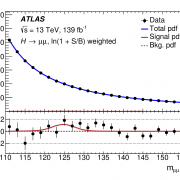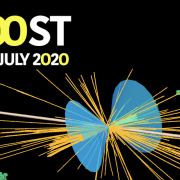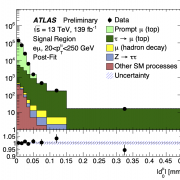Access to Collaboration Site and Physics Results

Using the full data sample from the LHC’s first run of proton-proton collisions, ATLAS has measured the production rate of top and anti-top quarks.

The resulting cross sections – 182.9 ± 7.1 picobarns at 7 TeV and 242.4 ± 10.4 picobarns at 8 TeV – measure how often top quark pairs are produced when protons collide. These new precise measurements are in agreement with recent predictions based on the theory of Quantum Chromodynamics.
The top quark is the heaviest subatomic particle ever observed, with a mass that is similar to that of an atom of gold. Top quarks also have a fleeting lifetime of about a trillionth of a trillionth of a second and are most often produced in pairs. When in pairs, striking physics events involving a range of subatomic particles – electrons, muons, particle jets from lighter quarks produced in the top quark decays, and neutrinos, which escapes unseen – light up the ATLAS detector. The signature of these physics events is also similar to those expected in many new Beyond the Standard Model theories.
The new production rate was measured by counting events with an electron, muon, and one or two jets that were likely to have originated from b-flavoured quarks, one of which is produced in each top quark decay. Comparing two independent samples, each rather pure in top-quark pair events, helps to minimise measurement uncertainties, resulting in total uncertainties on the production rates of about 4%. This is the smallest achieved for top quark pair-production measurements so far.
Since these predictions depend on the mass of the top quark, the latter can be inferred from the measured production rate, giving a value of mtop=172.9+2.5-2.6 GeV, consistent with values measured by studying the top quark decay products. The results are sensitive to new physics processes that could produce top-quark pairs beyond those predicted by the Standard Model, such as some Supersymmetry models which feature slightly heavier top quark partners called stops. Stops with masses between mtop and 177 GeV decaying into top quarks would increase the total top-quark pair production rate beyond what has been measured by ATLAS, and have now been excluded.








